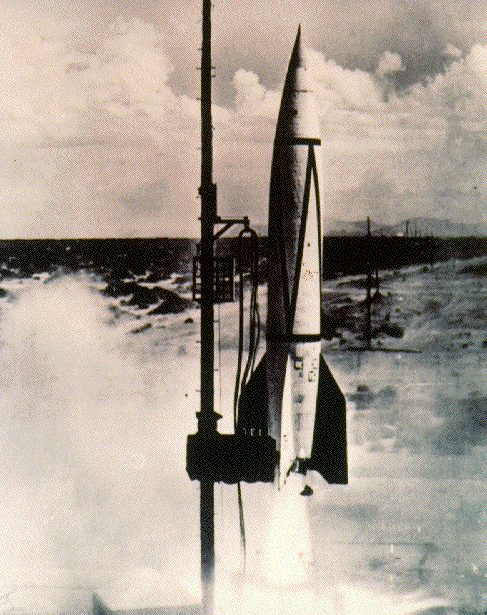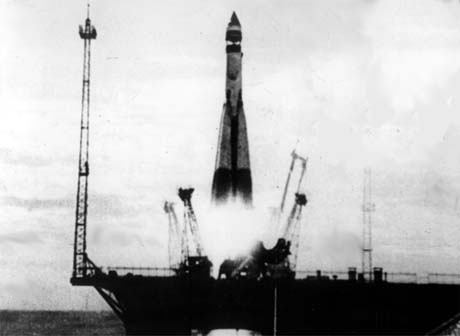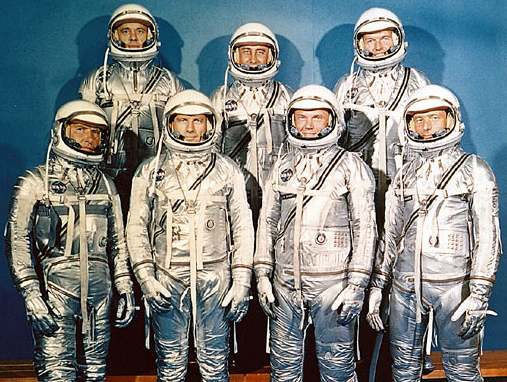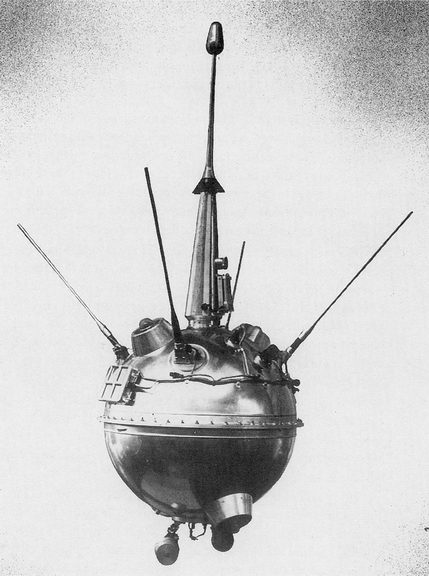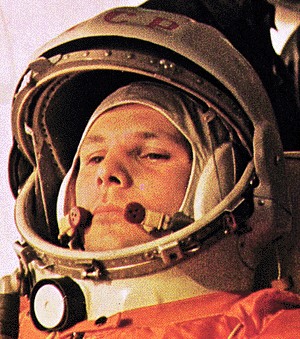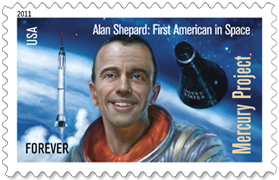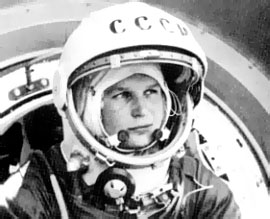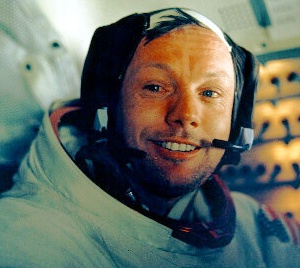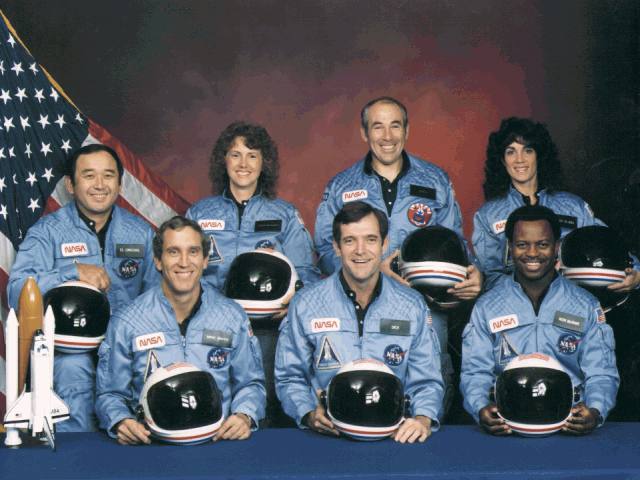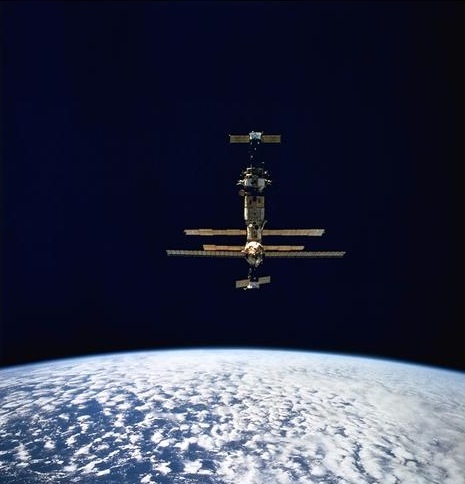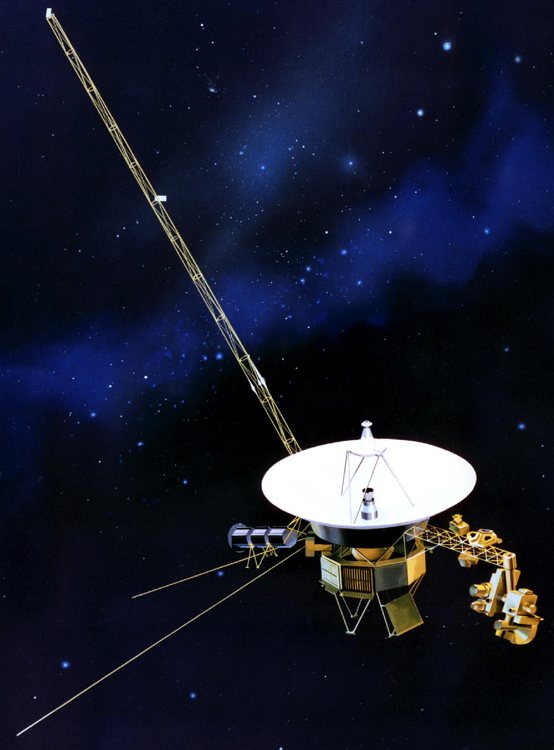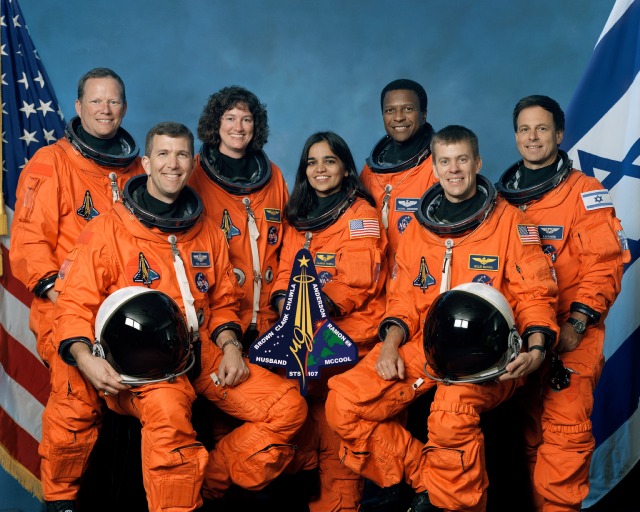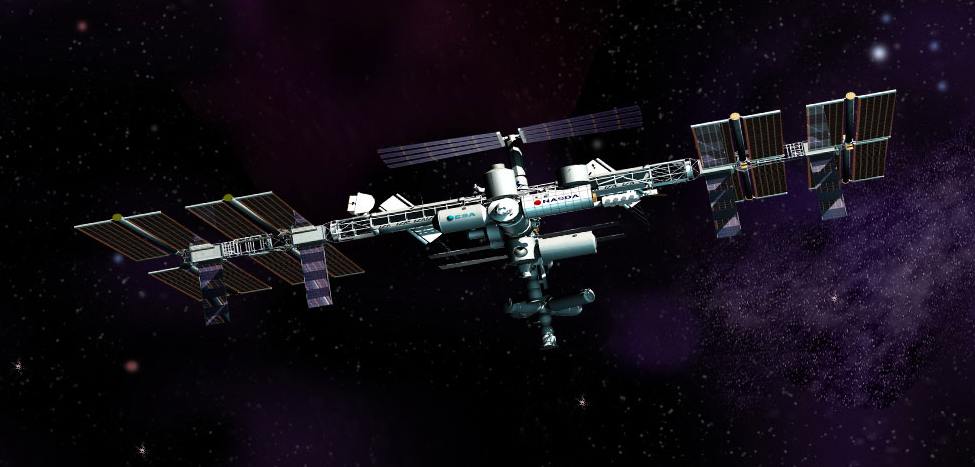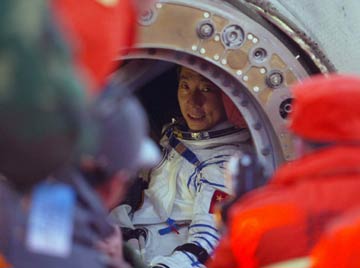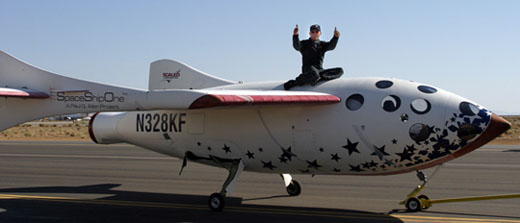| SPACE TODAY ONLINE COVERING SPACE FROM EARTH TO THE EDGE OF THE UNIVERSE | ||||||||||
| COVER | SOLAR SYSTEM | DEEP SPACE | SHUTTLES | STATIONS | ASTRONAUTS | SATELLITES | ROCKETS | HISTORY | GLOBAL LINKS | SEARCH |
The history of human spaceflight at a glance:
From V-2 to Voyager, Gagarin to Melvill
While Germans, Americans, Russians and others test fired rockets during the first half of the 20th century, the space race began in earnest after World War II.
During the war, which lasted from 1939 to 1945, German engineer Wernher Von Braun and his technical team built a rocket called V-2. It has been called one of the scariest Nazi weapons in World War II. In fact, more than 20,000 V-1 and V-2 rockets were fired by the Germans.
As Germany lost the war in 1945, Von Braun and some 55 rocket scientists surrendered to America and were relocated along with about 100 unfired V-2's to White Sands, New Mexico, and Fort Bliss, Texas, to work on a U.S. rocket program.
Other German rocket engineers were relocated to the Soviet Union where they also worked on unused German V-2's. The Russians tested their captured V-2's with launches from Kapustin Yar Cosmodrome on the banks of the Volga River 75 miles east of Stalingrad, now Volgograd.
With hundreds of follow-on rockets fired upward during the 1940s and 1950s, the far-reaching U.S. and Soviet space programs were well-founded on the original German V-2 rocket.
In 1955, the United States and the Soviet Union began planning space satellites for launch to Earth orbit during the International Geophysical Year 1957-1958.
Sputnik. While it seemed the United States had captured the prime German experts, it turned out to be the Soviets who managed to launch the first artificial Earth satellite. firsts »»
Sputnik 1 was sent to a 370 mile high orbit on October 4, 1957, stunning the population down on the planet's surface.
The USSR did it again on November 3 of that year when they launched Sputnik 2 carrying the dog, Laika, the first animal in orbit.
Ignominiously, the United States was unable to launch its Vanguard rocket and satellite in 1957. The next year, Explorer became the first successful American satellite.
The Moon. The National Aeronautics and Space Administration (NASA) was established in 1958.
NASA introduced the first American astronauts in 1959. The Mercury 7 were Walter H. "Wally" Schirra Jr., Donald K. "Deke" Slayton, John H. Glenn Jr., Scott Carpenter, Alan B. Shepard Jr., Virgil I. "Gus" Grissom, and L. Gordon Cooper.
Meanwhile, the Russians were on a roll. In 1959, the USSR launched three Luna probes to the Moon. Luna 1 was the the first spacecraft to reach the Moon. Luna 2 was the first to land on the Moon. Luna 3 snapped the first pictures of the far side of the Moon.
Yuri Gagarin. Even if the United States had the cream of German expertise, the Soviets again managed to reach a major milestone first when it launched the first person into space.
Yuri Alexeyevich Gagarin of the USSR rode the capsule Vostok 1 to orbit on April 12, 1961. He was first in space and first in orbit, completing one revolution around Earth in 1 hour 48 minutes. He landed in the Saratov area of Russia southeast of Moscow near the Volga River. gagarin »»
His was the first of many spaceflight milestones achieved first by the USSR. milestones »»
Playing catch up. Just 23 days after the Gagarin flight, NASA launched a Mercury-Redstone rocket carrying Alan Shepard on a 15-minute suborbital spaceflight in the Mercury capsule Freedom 7 on May 5, 1961. He was the first American in space, although not in orbit. Shepard splashed down safely in the Atlantic Ocean 302 miles from the launch pad at Cape Canaveral. shepard »»
U.S. President John F. Kennedy announced on May 25, 1961, at a special joint session of Congress that America would send men to the Moon before the end of the decade. kennedy »»
Gus Grissom, the second American in space, although still not in orbit, was launched on a similar 15-minute suborbital flight in the Mercury capsule Liberty Bell 7 on July 21, 1961. He, also, splashed down safely in the Atlantic 302 miles from Cape Canaveral. grissom »»
American space pilots became known as astronauts. Soviet space pilots became known as cosmonauts.
Another in orbit. Three months after Shepard's flight and less than one month after Grissom's, Gherman Titov of the USSR became the second man in orbit, completing 16 revolutions around the globe in 25 hours 18 minutes in the capsule Vostok 2 on August 6, 1961. He landed near Saratov, Russia.
While his stay of more than a day in orbit was another landmark for the USSR, Americans were determined to go forward with the space race.
An astronaut orbits Earth. John Glenn became the first American in orbit when he carried the U.S. flag for three trips around Earth in five hours in the Mercury capsule Friendship 7 on February 20, 1962. He splashed down in the Atlantic 800 miles southeast of Cape Canaveral near Grand Turk Island. glenn »»
Three months later, Scott Carpenter flew as the second American in orbit. He completed three trips around Earth in five hours in the Mercury capsule Aurora 7 on May 24, 1962. Carpenter landed in the Atlantic Ocean 1,000 miles southeast of Cape Canaveral. carpenter »»
First woman. Russian textile worker Valentina Tereshkova became the first woman in space when she blasted off in Vostok 6 on June 16, 1963. She stayed in orbit three days. women »»
First spacewalk. Spacewalks, or extra-vehicular activities (EVA), allow astronauts and cosmonauts to move between spacecraft and to maintain the outsides of their spacecraft.
The first spacewalk was taken by Alexei Leonov as he went outside the USSR's Voskhod 2 capsule for ten minutes on a 10-ft. tether on March 18, 1965.
Shortly thereafter, the first American spacewalker was Edward White who went outside the Gemini 4 capsule on a tether for 20 minutes on June 3, 1965. spacewalkers »»
Apollo 1 and Soyuz 1. Space travel is risky business. Exploration has been accompanied by loss of life.
In January 1967, while training for the first U.S. Apollo mission, astronauts Virgil "Gus" Grissom, Edward White, and Roger Chaffee died in a flash fire in their spacecraft on the launch pad. U.S. manned flights stopped for almost two years.
In April 1967, the USSR's Soyuz 1 flight ended in tragedy when the capsule's descent parachute did not open. Cosmonaut Vladimir Komarov died in the crash landing. Soyuz flights stopped for 18 months. spaceflight deaths »» dangerous trips »»
Moon research. Before sending men to the Moon, the United States sent 21 robot explorers – nine Ranger spacecraft from 1961-65, seven Surveyor spacecraft 1966-68, and five Lunar Orbiter spacecraft 1966-67.
Rangers were the first U.S. try for close-up images of the Lunar surface. The spacecraft flew straight into the Moon, sending pictures until impact. Three succeeded, six failed.
Surveyor probes were the first U.S. spacecraft to land safely on the Moon.
Lunar Orbiters mapped 99 percent of the lunar surface in search of Apollo landing sites. exploring the moon »»
Soviet preparations. The USSR completed 20 successful unmanned missions to the Moon, achieving a number of firsts – first probe to impact the Moon, first flyby and image of the lunar farside, first soft landing on the Moon, first lunar orbiter, and first circumlunar probe to return to Earth. The Soviet Union's two series of probes were Luna with 24 flights and Zond with five flights. The Luna series included two Moon rovers and three sample return missions.
First men at the Moon. The U.S.-USSR Moon race was well underway when the first men flew to Earth's natural satellite. The Apollo 8 astronauts Frank Borman, James Lovell and William Anders made a 147 hour round trip to the Moon and back in 1968. Their six-day flight was the longest on record to that time. They flew into lunar orbit on December 24, but they did not land on the lunar surface. They completed ten orbits of the Moon and sent live TV pictures of the Moon back to Earth.
Man on the Moon. Humans first set foot on Earth's natural satellite on July 20, 1969. As the lunar excursion module from the Apollo 11 capsule touched down on the barren surface of the Moon's Sea of Tranquility, astronaut Neil A. Armstrong said, "The Eagle has landed." He then stepped out onto the surface and said, "One small step for man, one giant leap for mankind." Edwin "Buzz" Aldrin landed with Armstrong on the Moon.
The Soviet Union had tried hard, but America won the race to the Moon. The Soviets decided to turn their efforts to space stations where men and women could live and work for long periods in Earth orbit.
U.S. astronauts completed six Moon landings between 1969-72. The ten other men who walked on the Moon in addition to Neil Armstrong and Buzz Aldrin were Pete Conrad, Alan Bean, Alan Shepard, Edgar Mitchell, David Scott, James Irwin, John Young, Charles Duke, Eugene Cernan and Harrison Schmitt. Cernan was the last man on the Moon. moonflight milestones »»
End of the Moon race. The Soviet Union's Moon rocket, known as N-1, reached the launch pad in 1969. Its first three launches were catastrophic failures. The rocket was flawed and the USSR killed its Moon program.
Staying on in space. A space station is a satellite like any other, except it can house people for long periods of time. Many unmanned satellites have been as large as a space station, flown at the same altitudes, and been as complex. The difference is in the life-support system which allows human occupants to live safely in the dangerous space environment.
The USSR won the competition for first space station with the launch of its Salyut-1 to a 200-mi.-high orbit on April 19, 1971. It went on to launch a total of eight space stations through 1986.
Meanwhile, having enjoyed large budgets during the 1960s, NASA wanted to continue into the 1970s with a space station in Earth orbit as a pit stop for astronauts on their way to the Moon and Mars. However, after six manned landings on the Moon, much of NASA's money dried up. Many politicians said space spectaculars were unnecessary since the U.S. had won the race. Forced to choose, NASA canceled three Moon landing flights and built a space station. The space agency sent Skylab up to Earth orbit on May 14, 1973. space stations »»
Leaving the Sun. An American interplanetary probe launched on September 5, 1977, would take humankind to and beyond the very edge of the Solar System. Voyager 1 was sent out from Cape Canaveral to fly by Jupiter in 1979 and Saturn in 1980. Then, the robot explorer just kept on going.
In November 2003, the spacecraft reached a distance 90 times farther from the Sun than the Earth. That's about 8.4 billion miles away.
Today, in that dark, cold, vacant neighborhood at the very edge of our Solar System, Voyager 1 holds the record as the Earth explorer that has traveled farthest from home. It is the most distant human-made object in the Universe. voyagers »» pioneers »»
Shuttle to orbit. A space shuttle is a piloted, recoverable, partially-reusable transportation vehicle used to carry people and cargo between Earth and space, and as a short-term research platform in orbit. It has wings for a controlled descent through the atmosphere returning people and materials to land on the surface. Unlike the billions of miles Voyager has flown away from Earth, space shuttles fly a mere 200 miles above Earth's surface.
U.S. President Richard Nixon approved the development of such a reusable space transportation system in 1972. Later, the Soviets began work on a similar shuttle.
The first American space shuttle, Columbia, carried astronauts John Young and Robert Crippen to orbit on a 54-hour maiden voyage on April 12, 1981.
Later, shuttle Challenger flew first on April 4, 1983. Discovery made its maiden voyage on August 30, 1984. Atlantis flew first on October 3, 1985. Endeavour took off on May 7, 1992.
Altogether, NASA has flown more than 100 shuttle missions. space shuttles »»
The USSR built on shuttle, Buran, which lifted off on its maiden voyage November 15, 1988. Buran means snowstorm in Russian. It was lifted to space by an Energia rocket, completed two orbits, and made an automated landing. No people were aboard. It never flew again as the USSR collapsed in 1991. end of the ussr »»
Challenger and Columbia. Space travel is risky business. The loss of shuttle Challenger just 73 minutes into lift-off on January 28, 1986, exemplifies the danger, as does the loss of shuttle Columbia descending over Texas on Feb. 1, 2003.
Seven astronauts, Francis R. "Dick" Scobee, Michael J. Smith, Judith A. Resnik, Ellison S. Onizuka, Ronald E. McNair, Gregory B. Jarvis, and Sharon Christa McAuliffe, were killed when one of Challenger's solid-fuel booster rockets leaked, leading to a massive liquid-fuel tank explosion above the Cape Canaveral launch pad.
NASA mission control reported at one minute thirteen seconds into the flight, "Obviously a major malfunction. We have no downlink. The vehicle has exploded."
McAuliffe was a Concord, New Hampshire, high school social studies teacher. Millions of American students in classrooms watching the televised launch were to have participated in lessons McAuliffe was to have taught later by TV from orbit.
U.S. President Ronald Reagan said America would never forget the Challenger astronauts who "slipped the surly bonds of Earth" to "touch the face of God."
It took NASA 975 days to recover from the Challenger explosion. The next flight was Discovery, on September 28, 1988. A new shuttle, Endeavour, built to replace Challenger, took off on its first flight on May 7, 1992. challenger »»
Years later, seven astronauts were returning from orbit aboard shuttle Columbia when it broke up 200,000 feet over Texas on Feb. 1, 2003. The shuttle was descending toward a landing at Kennedy Space Center in Florida. Debris was strewn across a wide area from southeastern Texas into Louisiana.
Aboard Columbia were astronauts Rick D. Husband, William C. McCool, Michael P. Anderson, David M. Brown, Kalpana Chawla, Laurel Clark, and Israel's first astronaut, Ilan Ramon. Ramon had been a national hero in Israel for taking part in the 1981 bombing of a nuclear reactor in Iraq.
U.S. President George W. Bush said, "The cause in which they died will continue. Mankind is led into the darkness beyond our world by the inspiration of discovery and the longing to understand. Our journey into space will go on."
It took NASA two years to recover from the Columbia explosion. columbia »»
International Space Station. A space station is a combined home, office, laboratory and observatory where human occupants can live and work safely for periods of time in the dangerous environment of outer space.
The Soviet Union had launched eight space stations between 1971 and 1986.
The last of the USSR's eight space stations was Mir. It was in service in orbit from 1986 to 1999. Some 100 cosmonauts and astronauts lived aboard Mir, including seven NASA astronauts, a Japanese journalist, a British candy maker and numerous visitors from other countries. Several were from countries that had no other access to space.
Russian cosmonaut Valery Polyakov stayed the longest, 438 days in 1994-95. Some 16,500 science experiments were conducted on board the station over 13 years.
The United States had launched one space station, in 1973. It was used only in 1973-74.
The International Space Station (ISS) was born in 1998.
With contributions from 16 nations, it is the largest and most complex international scientific project ever undertaken. The major partners are the United States, Russia, European Space Agency, Japan and Canada.
The first ISS section to be lifted to space was Russia's Zarya Control Module on November 20, 1998. Zarya, which means "sunrise" in Russian, was followed by America's Unity Node, a connecting segment, on December 4, 1998. Then, the Zvezda Service Module was sent up on July 12, 2000. Zvezda means "star" in Russian.
When completed around 2007, the ISS will have required dozens of shuttle flights to send up everything needed. It will weigh more than a million pounds and provide six state-of-the-art laboratories for international research at an altitude of 240 miles. international space station »»
People fly to the ISS in U.S. space shuttles and aboard Russian Soyuz transports. soyuz transports »»
The ISS is supplied by shuttles and Russian unmanned Progress freighters. progress freighters »»
Paying tourists already have begun to visit the space station. tourists »»
Latecomer. A long 42 years after Yuri Gagarin's historic launch, and after the flights of hundreds of men and women from many nations around the world, the Peoples Republic of China launched astronaut Yang Liwei in his Shenzhou 5 capsule to Earth orbit on October 15, 2003.
Liwei's first comments from space were, "I feel good." His flight made China the third nation able to send a human being to space, after the United States and Russia. china in space »»
Private astronauts reach space. Eight months after Liwei's flight from China, an American private company, Scaled Composites, sent its private astronaut Mike Melvill, on a suborbital flight in SpaceShipOne on June 21, 2004.
SpaceShipOne was lifted by an airplane from the Mojave, California, airport to a high altitude. From, there, SpaceShipOne blasted itself on up to space – above 62 miles altitude. It then glided back down to land at the airport.
How long will it be before private spacecraft carry private astronauts to orbit and beyond? private space planes »»
History is underway. From V-2 to Voyager, from Gagarin to Melvill, that's the story of human space exploration and travel in a nutshell.
Learn more:
- Man-in-Space Firsts STO »»
- Yuri Gagarin STO »»
- International Space Station STO »»
- Soyuz Transports STO »»
- Progress Freighters STO »»
- Space Tourists STO »»
- China in Space STO »»
- Shuttle Columbia STO »»
- Shuttle Challenger STO »»
- Space Shuttles STO »»
- Space Stations STO »»
- Spacewalkers STO »»
- Women in Space STO »»
- John Glenn STO »»
- SpaceShipOne flight Scaled Composites »»
- SpaceShipOne flight X Prize »»
- SpaceShipOne Vulcan »»
- Scaled Composites Scaled Composites »»
- Rutan Aircraft Designs Burt Rutan's Life »»
- Voyager Facts Dick Rutan's story »»
- Vulcan Inc. Vulcan »»
- X Prize Foundation X Prize »»
TOP OF THIS PAGE ROCKETS STO COVER SEARCH STO QUESTIONS ABOUT STO FEEDBACK © 2011 Space Today Online
